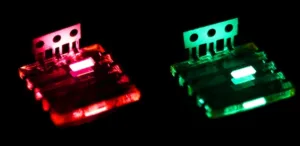Researchers at Korea’s Pohang University claim to have developed a perovskite LED (PeLED) with a luminous efficiency that can compete with phosphorescent OLEDs. The component could eventually be used in displays and lighting panels and is being developed in several places around the world (http://tinyurl.com/ojlxmjs).
Image: University of Cambridge (2014)
Perovskite is a mineral, mainly composed of calcium titanate, and also refers to any materials with the same crystal structure of cuboid and diamond shapes. Organic/inorganic hybrid perovskite has a colour purity higher than both OLED and QD LEDs. However, LEDs made using it have been developed before, but have exhibited a limited luminous efficiency. This was mainly due to significant exciton disassociation. Exciton is a complex of an electron and a hole, which enables light emission when radiatively recombined.
The Pohang team overcame this limitation using fine stoichiometric (i.e. components must be present in exactly the right amounts) tuning, which prevents exciton disassociation. They also used nanograin engineering to reduce perovskite grain size, and decrease exciton diffusion length. The effect has been to overcome the PeLED limitations, and boost efficiency levels.

